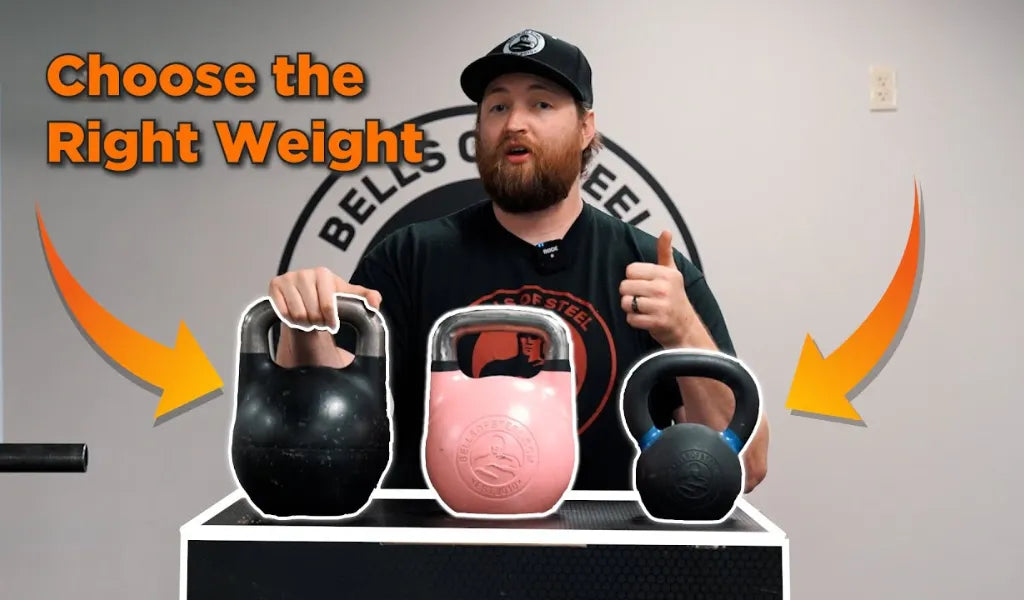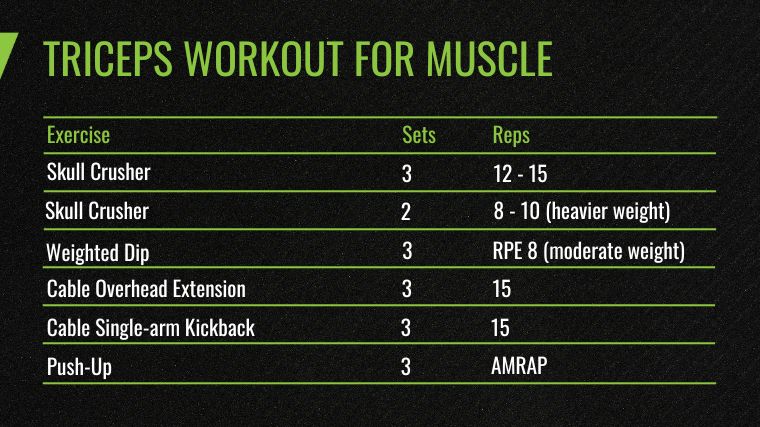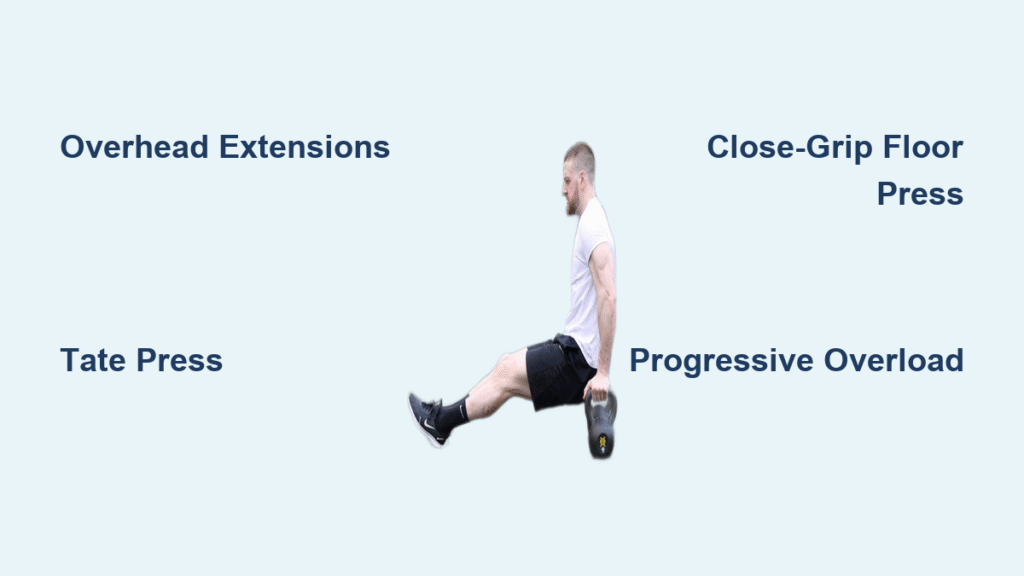Your triceps control whether you can finish that final bench press rep or your arms look weak in short sleeves. Most lifters neglect these crucial muscles, but kettlebells transform tricep training with unique instability that forces complete muscle engagement. Unlike barbells or machines, kettlebells work your triceps through their full range of motion while challenging your stabilizer muscles for greater growth.
This complete kettlebell tricep workout guide reveals exactly how to build powerful, defined arms using science-backed techniques. You’ll discover which kettlebell exercises target each of the three tricep heads, how to select the perfect weight for your skill level, and programming strategies that deliver visible results in weeks—not months.
Why Your Standard Tricep Routine Fails and Kettlebells Fix It
Kettlebells create tricep development through unstable loading that traditional equipment can’t match. The offset weight forces your muscles to work harder throughout each movement, particularly during the most challenging portions of the exercise. When you perform overhead extensions with a kettlebell, your stabilizer muscles engage intensely to control the bell’s position, creating more metabolic stress and muscle damage than standard dumbbell work.
The unique shape also allows deeper stretches at the bottom of movements like skull crushers, where the handle clears your forehead better than dumbbells. This increased range of motion creates greater muscle fiber recruitment across all three tricep heads. For immediate results, replace your next tricep session with just two kettlebell movements: overhead extensions and close-grip floor presses.
Long Head Activation for Complete Arm Development
Your long head makes up the majority of your tricep mass but remains underdeveloped in most lifters. Kettlebell overhead extensions solve this problem by placing your arm in the perfect 180° position for maximum long head stretch. When you lower the weight behind your head, you create tension through the full range that standard pushdowns can’t match.
Pro tip: Keep your elbows pointed forward during overhead work—flaring them reduces long head activation by 30%. For best results, perform single-arm extensions first to correct imbalances before moving to bilateral work.
Lateral and Medial Head Targeting for Arm Thickness
The horseshoe shape everyone wants comes from developed lateral and medial heads. Kettlebell Tate presses deliver this by forcing your elbows into a flared position while maintaining tension through the entire movement. Unlike flat bench presses where your chest takes over, the kettlebell’s instability keeps constant pressure on your triceps.
Common mistake: Letting your elbows drift during close-grip presses. Keep them tucked tight to your sides to maximize medial head engagement and prevent shoulder strain.
Kettlebell Selection: Your Secret to Faster Tricep Growth

Choosing the right weight determines whether you build muscle or just spin your wheels. Start lighter than you think—you should complete 10-12 smooth reps with perfect form before considering heavier bells.
Weight Progression Standards Based on Experience
Beginners: Women start with 8-12kg, men with 12-16kg. Intermediate lifters progress to 16-24kg, while advanced athletes use 24kg+ bells. Increase weight by just 2-4kg increments every 3-4 weeks—triceps respond better to gradual progression than sudden jumps.
Warning: Using too heavy a weight causes elbow strain and shifts work to your shoulders. If you feel shoulder tension during extensions, reduce the weight by 25%.
Grip Variations for Specific Muscle Targeting
The horn grip (hands on kettlebell sides) creates maximum instability for advanced lifters seeking greater muscle activation. The bell grip (hands on the kettlebell body) allows heavier loads with less wrist strain. Master the standard handle grip first before experimenting with advanced variations.
Top 3 Kettlebell Tricep Exercises That Deliver Real Results
Overhead Extensions: The Long Head Builder
Stand tall with feet shoulder-width apart, gripping the kettlebell bell with both hands. Lower behind your head until you feel an intense stretch, then drive upward until arms lock out. Keep elbows pointed forward—flaring reduces long head activation. Perform 3-4 sets of 8-15 reps.
Pro tip: Squeeze your lats and abs before each rep to protect your lower back. This creates a stable base for maximum tricep engagement.
Tate Press: The Complete Tricep Developer
Lie on your back holding the kettlebell by the horns with thumbs down. Lower to your chest with elbows flared wide, then press up using only your triceps. This unique angle hits all three heads simultaneously. Master 3 sets of 10-15 reps before increasing weight.
Key cue: Keep elbows wide throughout the movement—allowing them to drop reduces lateral head activation.
Close-Grip Floor Press: The Strength Builder
Lie supine with kettlebells at chest level, hands in a narrow grip. Press upward while keeping elbows tucked to your sides. This compound movement builds pressing strength while emphasizing tricep development. Work in the 6-12 rep range for 3-4 sets.
Progression: Once you master 12 reps, add a 2-second pause at the bottom to increase time under tension.
Smart Programming for Maximum Tricep Growth

Train triceps twice weekly for optimal development. Total weekly volume should reach 16-20 sets—split across push days or dedicated arm sessions. More frequent, moderate-volume training beats marathon arm days that leave you sore for days.
Rep Range Strategy for Your Goals
- Compound movements: 6-12 reps for strength
- Isolation exercises: 8-20 reps for hypertrophy
- Bodyweight movements: 10-20 reps for endurance
Progressive Overload Methods That Work
Increase weight by 2-5kg when you exceed rep targets. Add sets gradually—start with 3, progress to 4-5. Extend range of motion by performing deficit movements (using a weight plate under your head for skull crushers). Implement paused reps or slow eccentrics for advanced progression.
Sample 15-Minute Kettlebell Tricep Workout
Complete this circuit when time is limited but you want maximum results:
- Push-ups on kettlebells: 40 seconds
- Single-arm overhead extension (left): 40 seconds
- Single-arm overhead extension (right): 40 seconds
- Tate press: 40 seconds
- Tricep dips on kettlebells: 40 seconds
Rest 20 seconds between exercises. Complete 3-4 rounds. Increase rounds as conditioning improves—this circuit builds strength, size, and endurance simultaneously.
Technique Mastery Secrets for Injury-Free Growth
Lock your elbows in position during isolation movements—moving elbows reduces tricep tension. Depress your shoulder blades to protect joints and maximize muscle recruitment. Control the eccentric (lowering) phase for 2-3 seconds to create more muscle damage.
Critical Form Errors That Sabotage Results
Elbow flaring: Reduces mechanical tension on triceps by up to 40%. Keep elbows tucked for maximum growth. Using momentum: Kipping weights reduces muscle activation by shifting work to larger muscle groups. Control every inch of movement. Overextending range: Stop when you feel joint discomfort, not when the weight stops moving.
Essential Safety Protocol
Warm up with 5-10 minutes of arm circles and light sets. Start each new exercise with 50% of your working weight. Stop immediately if you feel sharp pain in elbows or shoulders. Progress gradually—triceps respond better to consistency than intensity spikes.
Bench Press Carryover: How Kettlebells Boost Your Lockout
Kettlebell JM presses and floor extensions directly improve lockout strength for powerlifting. The instability factor strengthens stabilizer muscles neglected by barbell training. Include these movements 8-12 weeks before competitions for dramatic improvements in your bench numbers.
Pro tip: Perform close-grip floor presses after heavy squats on leg day—this placement ensures your triceps are pre-fatigued for maximum growth stimulation.
Performance Tracking System for Visible Progress
Track your 10-rep max on overhead extensions monthly. Monitor total weekly tonnage (sets × reps × weight). Film your form quarterly to identify technique drift. Note any elbow or shoulder discomfort patterns—these often indicate form breakdown before pain occurs.
Warning signs of overtraining: Persistent elbow pain outside workouts, decreased performance in pressing movements, loss of pump during training. Reduce volume by 30% if you notice these signs.
Transform your triceps from weak links into powerful assets using these proven kettlebell techniques. Start with the fundamentals, progress systematically, and track your results. Your arms will thank you when shirt sleeves become your biggest limitation—consistent kettlebell tricep work delivers results that traditional equipment can’t match.




